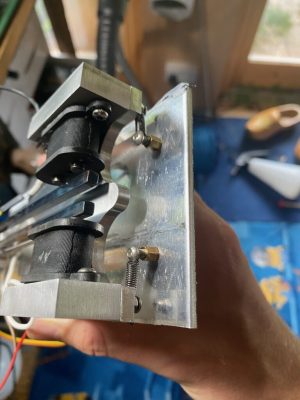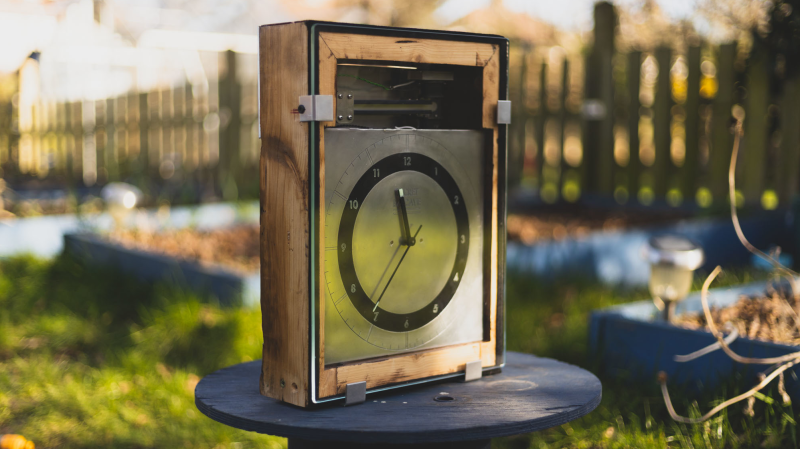[Willem Koopman aka Secretbatcave] was looking at a master clock he has in his collection which was quite a noisy device, but wanted to use the matching solenoid slave clock mechanism he had to hand. Willem is a fan of old-school ‘sector’ clocks, so proceeded to build his ideal time piece — Vibrmatic — exactly the way he wanted. Now, since most time keeping devices utilise a crystal oscillator — which is little more than a lump of vibrating quartz — why not scale it up a bit and use the same principle, except with a metal tuning fork? (some profanity, just to warn you!)

A crystal oscillator operates in a simple manner; you put some electrical energy in, it resonates at its natural frequency, you sense that resonance, and feed it back into it to keep it sustaining. With a tuning fork oscillator, the vibration forcing and the feedback are both done via induction, coils act as the bridge between the electronic and mechanical worlds.
By mounting the tuning fork onto a shock mounting, the 257 Hz drone was kept from leaking out into the case and disturbing the household. This fork was specified to be 256 Hz, but [Willem] reckons the drag of the electromagnets pushed it off frequency a bit. Which make sense, since its a mechanical system, that has extra forces acting upon it.
The sector face was CNC cut from aluminium, the graphics engraved, then polished up a bit. Finally after a spot of paint, it looks pretty smart. Some nice chunks of upcycled wood taken from some building work spoils formed the exposed enclosure. On the electronics side, after totally ignoring the frequency error, and then tripping over a bunch of problems such as harmonics in the oscillation, and an incorrectly set-up divider, a solution which seemed to work was found, but like always, there are quite a few more details to the story to be found in the build log.
We’ve seen a tuning fork clock recently, like this 440 Hz device by [Kris Slyka] that the project above references, and whilst we’re talking about tuning forks, here’s a project log showing the insides of those ubiquitous 32.768 kHz crystal units.
















“Vibrmatic” ???
Shouldn’t this be “vibromatic”?
What does either one mean and why is it a tag too?
Is it the name [Willem Koopman aka Secretbatcave] gave his build? than maybe not tag worthy?
The Bulova Accutron wristwatch from the 1960’s used a 360 Hz tuning fork driven by a one-transistor oscillator. A little hair-fine prod attached to one of the tines pushed the first gear in the train that drove the hands. Good for better than a minute a month, if you didn’t bump it too much. Had to be careful to lay it on its back at night; on edge, the fork coupled the whine into any surface it was placed on.
The tuning fork drive also eliminated the tick-tick-tick sound. In their advertising, Bulova actually tried using this as a selling point, despite a 360Hz tone being a lot more audible than a conventional movement’s ticking.
I would even go so far as to say it wasn’t very discreet at all.
Yes, well, it pays to check one’s title. Obviously that should be discrete, but I can’t actually change that now.
Proofreading your own work doesn’t work that well. If you can make a mistake in the first place then it’s exceptionally easy to overlook it when you proof read your own work.
But that’s all good, there are a lot of proof readers here for HaD staff! And we’re certain to let them know :) hopefully in a positive way.
The quartz crystal clock is silent and more accurate and is thus far less satisfying to watch than a tuning fork, or pendulum,
or a balance wheel, or a little girl bouncing on a spring (which is my favorite.) But the high frequency doesn’t allow time for outside influences to upset things between oscillations, and the crystal–be it quartz or another piezoelectric material–can be made such that temperature changes won’t affect its frequency. When the crystal clock was introduced 100 years ago all serious research involving mechanical time-keeping abruptly ceased.
And you could also say that when time measurement progressed to counting oscillations produced by specific quantum events, research in methods like mechanical resonance in crystals dropped off as well. But it doesn’t mean there is no place for crystals, and I still have a metal tuning fork for tuning musical instruments, because even though it’s not the most accurate method, it’s accurate enough and the battery hasn’t died once in the decades I’ve had it.
Oh great.
Now I’m picturing a tuning fork, made out of dead batteries.